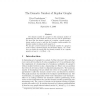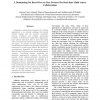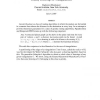2487 search results - page 92 / 498 » Partitions of Graphs into Trees |
ARSCOM
2004
13 years 9 months ago
2004
The domatic number of a graph G is the maximum number of dominating sets into which the vertex set of G can be partitioned. We show that the domatic number of a random r-regular g...
CORR
1999
Springer
13 years 9 months ago
1999
Springer
We solve the subgraph isomorphism problem in planar graphs in linear time, for any pattern of constant size. Our results are based on a technique of partitioning the planar graph ...
WETICE
2007
IEEE
14 years 3 months ago
2007
IEEE
Designing a collaborative architecture for real-time applications is an intricate challenge that usually involves dealing with the real-time constraints, resource limitations and ...
SODA
2008
ACM
13 years 11 months ago
2008
ACM
Greedy Routing is a class of routing algorithms in which the packets are forwarded in a manner that reduces the distance to the destination at every step. In an attempt to provide...
SBACPAD
2003
IEEE
14 years 2 months ago
2003
IEEE
— Scheduling by Edge Reversal (SER) is a fully distributed scheduling mechanism based on the manipulation of acyclic orientations of a graph. This work uses SER to perform constr...



